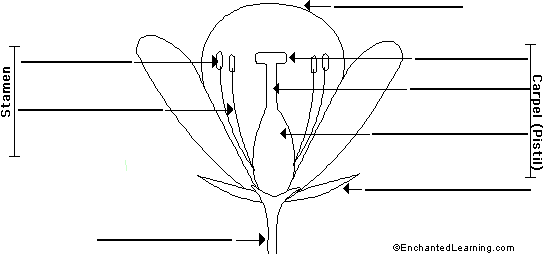Cards In This Set
| Front | Back |
|
What is the ploidy of a sporophyte?
|
2N (diploid)
|
|
What is the ploidy of a gametophyte?
|
N (haploid)
|
|
What is the role of meiosis and mitosis in the formation of pollen in angiosperms?
|
1. Microsporocytes (2N) divide by meiosis resulting in 4 microspores (N)2. Each microspore divides once by mitosis forming a tube cell and a generative cell3. The cells mature into a single pollen grain--- generative cell will divide to form 2 spermPOLLEN---mobileonly contributes nuclei
|
|
What is the role of meiosis and mitosis in the formation of eggs in angiosperms?
|
1. Megasporcyte (2N) undergoes meiosis resulting in four megaspores (N)2. Three of the megaspores degenerate3. Surviving megaspore divides by mitosis (3 times NO CYTOKINESIS) to form 8 haploid nuclei4. 8 nuclei rearrange5. cell walls form to yield 7 cells (large central cell has 2 nuclei)EMBRYO SAC--- non-mobile-contributes cytoplasm/organelles to the zygotes
|
 Label the flower |
Carpel-- stigma, style,ovaryStamen-- anther, filamentPetalSepalReceptacle
|
|
In what structures are each gametophyte found?
|
Microsporocytes reside in the antherMegasporocytes reside in the ovule
|
|
Self-fertilization (in terms of selective advantages of each)
|
-easier (sure thing)-less genetic diversity-it is going to happen
|
|
Outcrossing (in terms of selective advantages of each)
|
-creates more genetic diversity (desired traits continue)-may not happen
|
|
Why is fertilization in angiosperms referred to as "double fertilization"?
|
Because one sperm nucleus unites with egg nucleus to form the zygote (2N)The other sperm nucleus moves through the female gametophyte and fuses with the polar nuclei in the central cells to create the endosperm (3N)
|
|
How are the cotyledons of a bean and the endosperm of a corn seed similar?How are they different?
|
Bean-- -has 2 cotyledons-nutrients in the endosperm are absorbed by the cotyledons and stored-no endosperm is left by the time the seed matures (cotyledon functions as the nutrient storage organ)-no endosperm-- lacking 3N
Corn--- one cotyledon-endosperm is intact |
|
What are the characteristics of a mature seed?
|
- embryo-food supply-- originating with endosperm-seed coat
they allow offspring to be much more successful in colonizing dry habitats Mature seed is only 5 to 20% water where a normal plant is 90% water |
|
What are some environmental conditions that break seed dormancy and why are they significant in terms of seed success?
|
Dormancy-- seeds may not germinate fora period of time once they are dispersed from the parent plant-- usually a feature of seeds from species that inhabit seasonal environments WATERHEATACID LIGHT
ABSOLUTE REQUIREMENT IS WATER Abrasion( in addition to water and oxygen)-Revolving drums along pieces of sandpaper (scarified) abrasion from sandpaper scarifies the seeds -- in nature: seed coat can be disrupted by fire, by passage through an animal's digestive tract (exposed to acid and then pooped out) or by abrasion against wind-or water driven soil particles. Environmental Conditions: (in addition to exposure to water)- Seeds that live northern or alpine areasseeds must undergo a period of cool, wet conditions before they will germinate --seeds native to wildfire habitatsmust be exposed to fire or smoke before they will germinate Small-seeded Species--need to germinate near the soil surface where individuals are exposed to light and can feed themselves via photosynthesis. |
|
Characterize the phases of the shoot apical meristem
|
SAM - either be1. vegetative-- leaves (more photosynthesis, sugars)2. reproductive-- flowers (enough energy to support)
|
|
What are some environmental factors that influence the transition to flowering?
|
-day length (season-- short or long)-temperature (season)-internal cues
|
|
What is the role of Flowering Locus C (FLC) in determining the timing of the transition to flowering?
|
An inhibitor of flowering-- it has a major effect of timing of flowering
flc/flc= early flower (low vegetation) FLC/flc or FLC/FLC= late flowering (high vegetation) |



